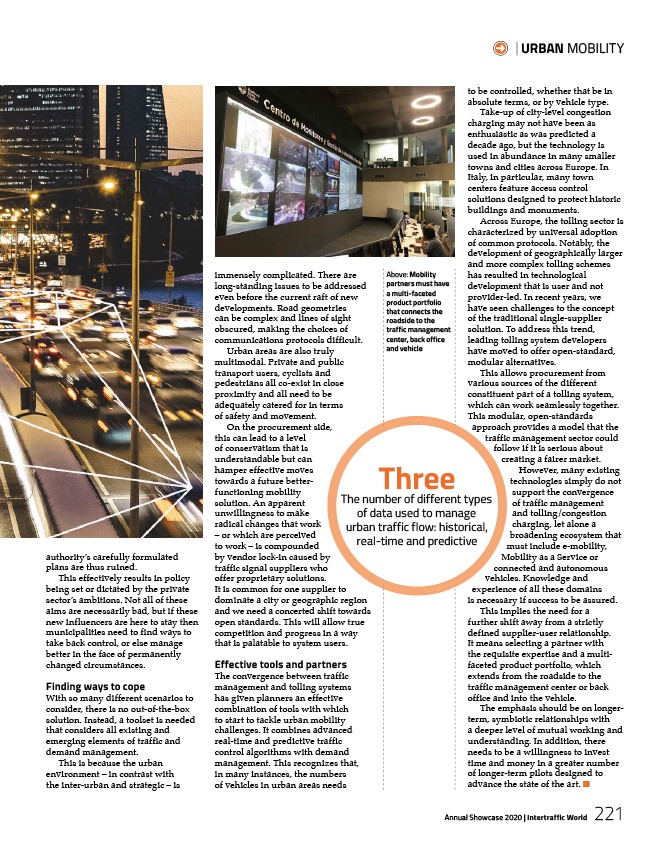
| URBAN MOBILITY
Above: Mobility
partners must have
a multi-faceted
product portfolio
that connects the
roadside to the
traffic management
center, back office
and vehicle
Three The number of different types
of data used to manage
urban traffic flow: historical,
real-time and predictive
Annual Showcase 2020 | Intertraffic World 221
immensely complicated. There are
long-standing issues to be addressed
even before the current raft of new
developments. Road geometries
can be complex and lines of sight
obscured, making the choices of
communications protocols difficult.
Urban areas are also truly
multimodal. Private and public
transport users, cyclists and
pedestrians all co-exist in close
proximity and all need to be
adequately catered for in terms
of safety and movement.
On the procurement side,
this can lead to a level
of conservatism that is
understandable but can
hamper effective moves
towards a future betterfunctioning
mobility
solution. An apparent
unwillingness to make
radical changes that work
– or which are perceived
to work – is compounded
by vendor lock-in caused by
traffic signal suppliers who
offer proprietary solutions.
It is common for one supplier to
dominate a city or geographic region
and we need a concerted shift towards
open standards. This will allow true
competition and progress in a way
that is palatable to system users.
Effective tools and partners
The convergence between traffic
management and tolling systems
has given planners an effective
combination of tools with which
to start to tackle urban mobility
challenges. It combines advanced
real-time and predictive traffic
control algorithms with demand
management. This recognizes that,
in many instances, the numbers
of vehicles in urban areas needs
to be controlled, whether that be in
absolute terms, or by vehicle type.
Take-up of city-level congestion
charging may not have been as
enthusiastic as was predicted a
decade ago, but the technology is
used in abundance in many smaller
towns and cities across Europe. In
Italy, in particular, many town
centers feature access control
solutions designed to protect historic
buildings and monuments.
Across Europe, the tolling sector is
characterized by universal adoption
of common protocols. Notably, the
development of geographically larger
and more complex tolling schemes
has resulted in technological
development that is user and not
provider-led. In recent years, we
have seen challenges to the concept
of the traditional single-supplier
solution. To address this trend,
leading tolling system developers
have moved to offer open-standard,
modular alternatives.
This allows procurement from
various sources of the different
constituent part of a tolling system,
which can work seamlessly together.
This modular, open-standards
approach provides a model that the
traffic management sector could
follow if it is serious about
creating a fairer market.
However, many existing
technologies simply do not
support the convergence
of traffic management
and tolling/congestion
charging, let alone a
broadening ecosystem that
must include e-mobility,
Mobility as a Service or
connected and autonomous
vehicles. Knowledge and
experience of all these domains
is necessary if success to be assured.
This implies the need for a
further shift away from a strictly
defined supplier-user relationship.
It means selecting a partner with
the requisite expertise and a multifaceted
product portfolio, which
extends from the roadside to the
traffic management center or back
office and into the vehicle.
The emphasis should be on longerterm,
symbiotic relationships with
a deeper level of mutual working and
understanding. In addition, there
needs to be a willingness to invest
time and money in a greater number
of longer-term pilots designed to
advance the state of the art. ■
authority’s carefully formulated
plans are thus ruined.
This effectively results in policy
being set or dictated by the private
sector’s ambitions. Not all of these
aims are necessarily bad, but if these
new influencers are here to stay then
municipalities need to find ways to
take back control, or else manage
better in the face of permanently
changed circumstances.
Finding ways to cope
With so many different scenarios to
consider, there is no out-of-the-box
solution. Instead, a toolset is needed
that considers all existing and
emerging elements of traffic and
demand management.
This is because the urban
environment – in contrast with
the inter-urban and strategic – is